Still Air Box Guide: why and how
Still Air Box (SAB) is an easy DIY solution for maintaining a high level of sterility in mycological procedures. Building one takes approximately 15 minutes and costs around $15. I suggest using this setup as a cheap alternative to a Laminar Flow Hood or Fan Filter Unit, especially for the first attempts in mycology. However, experienced mushroom cultivators use SAB as well.
What is a still air box
Still Air Box (SAB) is a transparent plastic box with limited airflow. It is used in mycology projects, such as working with syringes, grain jars/bags, and agar. The SAB is designed with armholes for accessing and manipulating the materials inside.
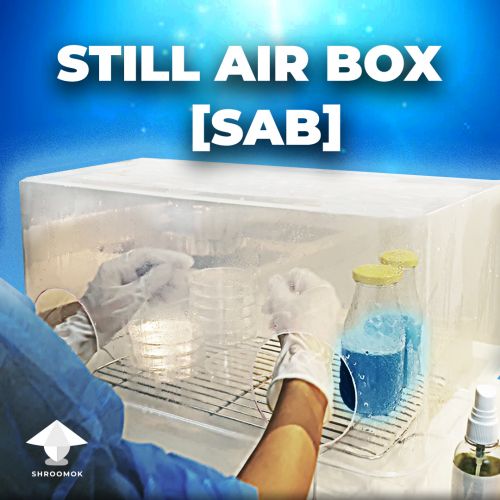
While the setup is not 100% sterile, it helps to reduce the concentration of contaminants that can be found in the air, such as mold spores, bacteria, and viruses. Although not flawless, a sterile SAB combined with proper handling techniques by the cultivator can significantly enhance the success rate of mycology projects.
Do you need SAB
I suggest to use Still Air Box for any contamination risky mycological operations. Mushroom culture is more susceptible to contamination when it is young and weak. Sterility is crucial during the early stages of mushroom growing such as spore germination and mycelium development.
Let's explore some cases when SAB is a must, when it is desirable, and when it may not be necessary.
SAB is necessary for:
🔶 Making Spore Syringe from a piece of spore print and spore syringe dilution. Read more

🔶 Grain to Grain (G2G) transfer. Read more
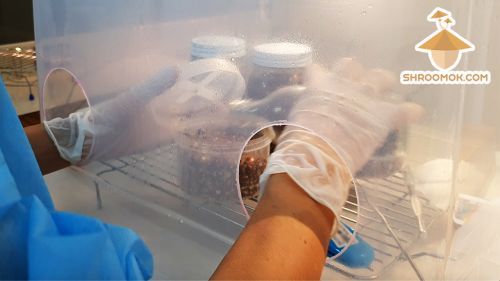
🔶 Agar work: pouring hot agar, all types of agar inoculation, contamination test for liquid culture or spore syringe, making Liquid Inoculant (LI) from agar, Agar to Agar (A2A) transfer for selection and strain isolation, Agar to Agar (A2A) transfer for 'cleaning' mushroom culture with contamination.
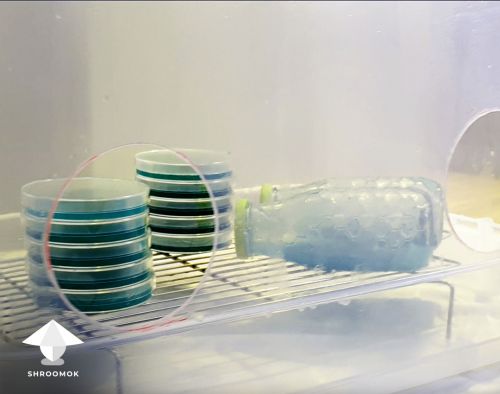
❗️Use SAB when you need to extract and save mushroom culture from contaminated agar plate by transferring healthy mycelium samples to the new agar plate. In this case SAB is the right tool for the task. Don't use laminar flow hood, you'll spread contamination in the air.
🔶 Mushroom cloning on agar and making mushroom tissue biopsy with the next liquid culture media inoculation
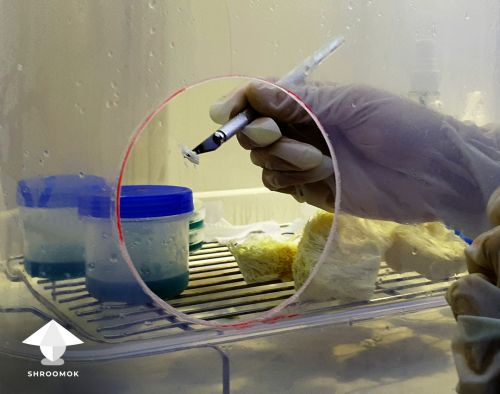
SAB would be great for:
🔶 Inoculation: grain jars/bags, liquid culture media. Read more
SAB not needed for:
🔶 Making spore syringe in zip bag without opening it. Read more
🔶 Spawn to Bulk and Casing. Read more
Building Still Air Box
SAB implementation is dramatically simple. It consists of two main steps:
- select appropriate plastic storage box
- make two armholes in it
That's it! I bet most of the components and needed equipment can be found at home or garage
Materials needed:
- 🔹 Large transparent plastic storage box: The larger, the better. I recommend using a box that is 50+ quarts (liters) in size. Choose a box that is wider than the width of your shoulders to ensure convenience while working inside the SAB. You can find affordable boxes at major stores for $15-25, often cheaper than on Amazon.
- 🔹 Permanent Marker and Ruler
- 🔹 Raised wire rack for baking/BBQ/microwave/storage shelf: The height should be around 2-4 inches or 5-10 cm.
- 🔹 Metal tin can (such as a tuna/coffee/soup can, or metal mug) that fits the diameter of your forearm, approximately 4 inches or 10 cm in diameter.
How to place holes in still air box
Let's simulate the process of creating armholes in the SAB to ensure they are placed properly.
- Position the plastic bin on your working table, with one of its wide sides facing towards you.
- Place a raised wire rack inside the bin.
- Sit in front of the box in a comfortable position.
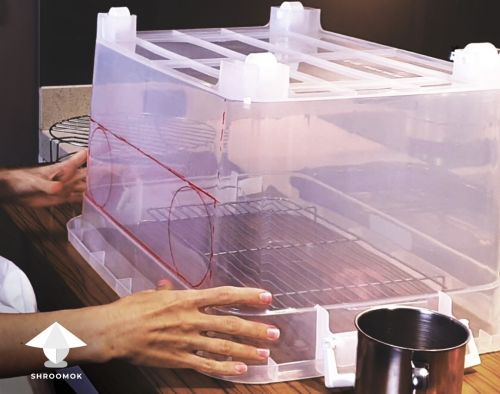
Plan holes in SAB 💡 Tip: I personally prefer using the SAB upside down. This is because the box often has a frustum shape, resembling a truncated pyramid, where the top is wider than the bottom. By using it this way, I have more space to work with. Furthermore, if the box has wheels, it can be unstable when working in the SAB. However, some growers choose to use a box with the closed lid on top. It's not a mistake; it simply comes down to personal preference and convenience. The choice is yours!
- Extend your hands forward towards the box, ensuring that your shoulders are lowered and relaxed. Adjust the height of your chair if necessary. To facilitate convenient work inside the SAB, the armholes should be made according to the following guidelines: 1) Keep the armholes shoulder-width apart (individual).
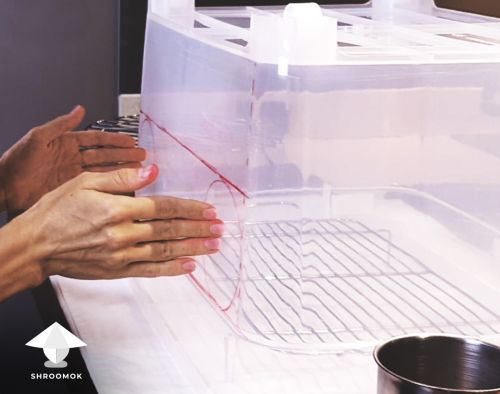
Imitate your work in SAB to know the right position of armholes
2) Position the armholes above the raised wire rack. The recommended height is approximately 2-4 inches or 5-10 cm. In my case, the wire rack's height is around 2" or 5 cm.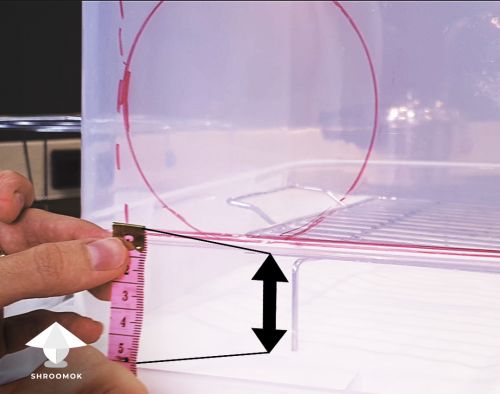
SAB holes height = the height of the raised wire rack ❗️Don't place the armholes too high or very close to each other. Doing so will limit your mobility inside the SAB. Remember to keep your shoulders relaxed and, if needed, put your elbows on the table for a short break while working inside the SAB.
- To outline the placement of the future armholes, you can use a tin can or a mug with a diameter of approximately 4 inches or 10 cm
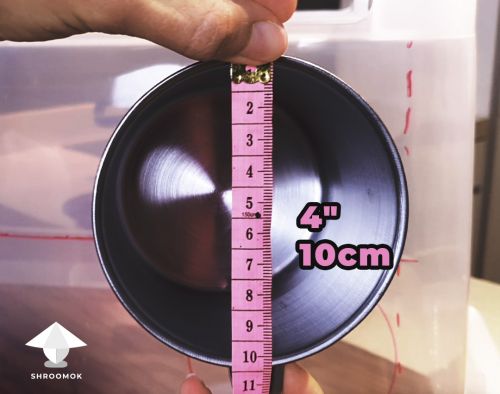
Common armholes diameter for SAB - Draw two parallel circles on the box with a Permanent Marker for indicating the locations where the armholes will be made

- Test the future SAB again to be sure it's right for you. Make any necessary adjustments to the armhole placement if required.
How to cut holes in plastic box without breaking it
There are three options available for cutting the holes:
Option 1. Hot tin can method
Materials needed:
- 🔹 Metal tin can (tuna, soup, coffee, mug) with a diameter of about 4 inches or 10 cm.
- 🔹 Hot plate / Cooktop / Electric Grill
- 🔹 Oven mitt / Towel
- 🔹 Face mask
- 🔹 Sharp knife / Razor Blade / Scalpel / Utility Knife
- Place the metal tin can or mug upside down on a hot plate, cooktop, or electric grill.
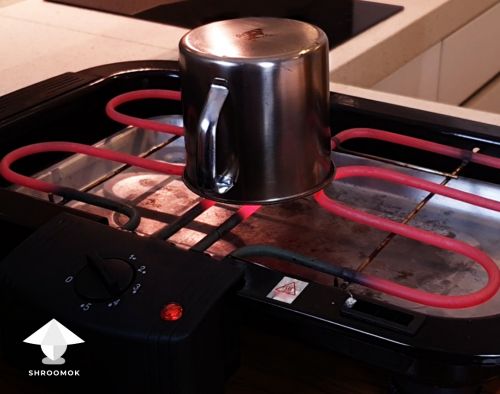
Metal mug on a hot electric grill - Once the rim of the can is hot enough, use an oven mitt or thick towel to hold it.
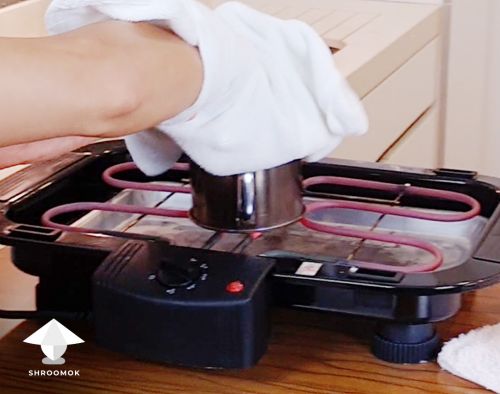
Hold the hot tin can with oven gloves or thick towel - Press the hot can against the plastic at one of the marked armhole locations. While pressing, twist the can to melt the plastic.
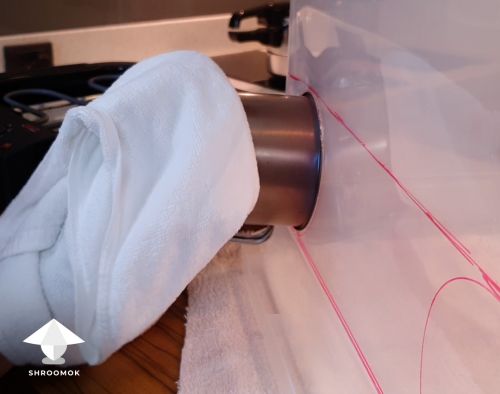
Press hot tin can or metal mug. Twist it clockwise as you press to melt the plastic and create a hole ❗️Wear a face mask to avoid inhaling fumes from the melting plastic. Perform this process outdoors or with proper ventilation
- The melted plastic will form a circle that can be popped out, creating a hole.

Melted plastic form a perfect hole in still air box - Repeat this process for the second armhole.
- Use a scalpel, sharp knife, razor blade, or utility knife to trim any rough edges around the holes. The edges should be smooth to prevent snagging on gloves or irritating the skin.
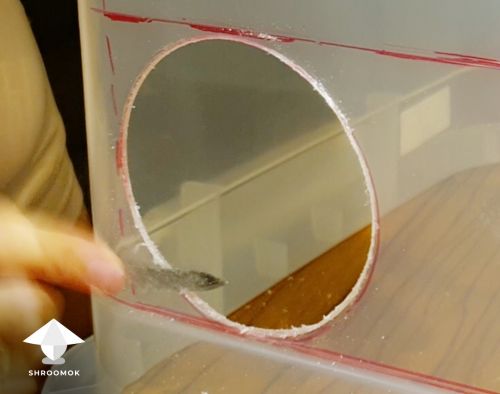
Make a smooth holes in still air box - Your still air box is ready!
Option 2. Drill with a hole saw
Materials needed:
- 🔹 Drill and Hole Saw Kit (Amazon)
- 🔹 Sharp knife / Razor Blade / Scalpel / Utility Knife
- 🔹 Protective goggles or sunglasses
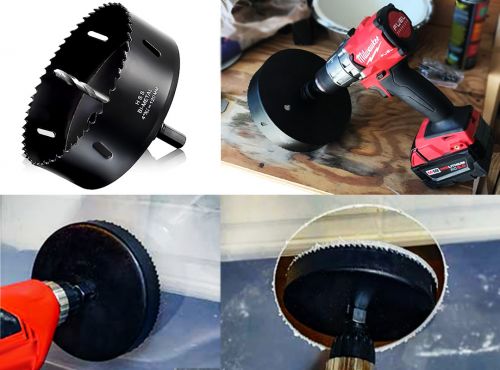
Drill with hole saw to cut holes in still air box
- Assemble the 4-inch or 10 cm hole saw and attach it to the drill bit.
- Align the drill bit with the marked hole using one hand while holding the box steady with the other hand to prevent it from moving.
❗️Note: Remember to wear protective goggles or sunglasses to shield your eyes from any debris or plastic particles that may be generated during the drilling process.
- Begin drilling the hole slowly and steadily. It's important to drill at a slow pace to avoid causing the plastic to crack.
- Carefully remove the plastic ring from the drill bit.
- Make a second hole in the box following the same procedure.
- Trim the edges and remove any jagged edges around the holes using a scalpel, sharp knife, or razor blade. It's important to ensure that the edges are smooth to avoid snagging on your gloves and causing damage to your skin.
- Ready!
Option 3. Dremel rotary tool
Materials needed:
- 🔹 Dremel rotary tool (Amazon)
💡 Tip by NightShiftNinja: For cutting hole in a plastic tub for a SAB if a person has a Dremel rotary tool the circle guide will make extremely quick work of it. It took me longer to measure out the spacing than it did to make the perfectly clean cuts
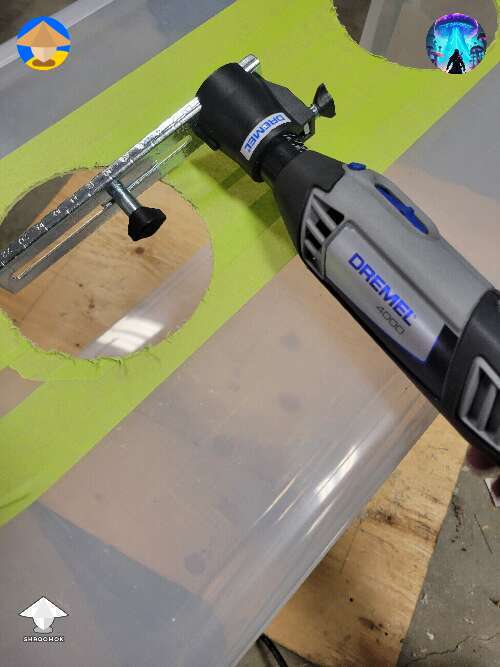
Tips for using a still air box
Materials needed:
- 🔹 Still Air Box
- 🔹 Raised wire rack for baking/BBQ/microwave/shelf rack, the height ~2-4" or 5-10 cm (Amazon)
- 🔹 Disinfectant: Ethyl or Isopropyl Rubbing Alcohol 70% (Amazon)
- 🔹 Disinfectant: bleach powder for making 1:10 solution or Clorox ready to use solution/spray/wipes (Amazon)
- 🔹 Clean non-porous surface (smooth table surface / plastic lid from the plastic box / PE film / aluminium foil)
- 🔹 Optional: Desk Lamp
- 🔹 Optional: Towel
1. Turn off the ventilation, air conditioning, or fan in the room 1-2 hours before working in the SAB to allow the air to settle. Ensure that the area is free from drafts and vibrations.
2. Thoroughly wash the SAB inside and outside with dishwashing liquid or a bleach solution (1:10). If using bleach, remember to wear gloves. Rinse well and let it dry.
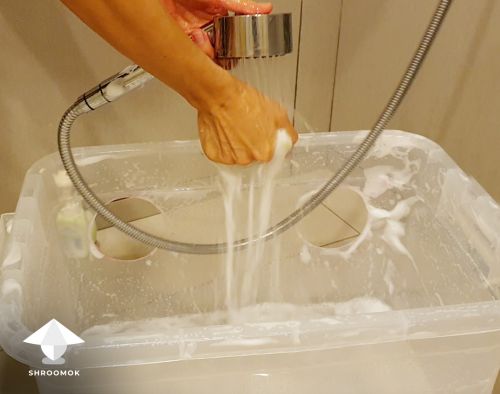
3. Prepare a sterile non-porous surface for the SAB, such as a table, plastic lid from the box, or cover the table with PE film or aluminum foil. Wipe it thoroughly with 70% ethyl/isopropyl alcohol.
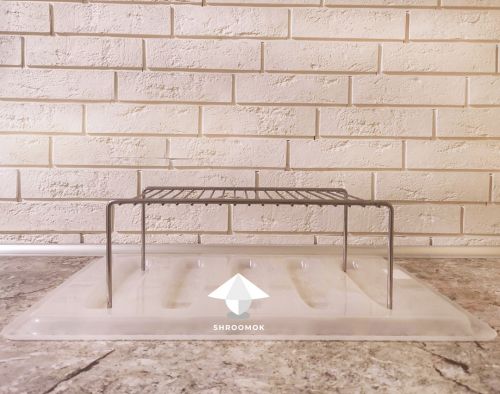
💡 Tip: To protect the bottom of your SAB, you can use a towel or fabric soaked in a bleach solution (1:10). Squeeze out excess liquid and place it at the bottom of your SAB.
💡 Tip: You can use soap solution (a few cc/ml per cup of water) to spray the towel on the bottom to help airborne contaminants stick to the soap film.

4. Wash your hands, wear a lab coat or clean light clothes, and put on a face mask for contamination protection and to reduce air currents from breathing. Wear disposable medical nitrile gloves and treat them with ethyl/iso alcohol 70%. Remember, the cultivator themselves can be a vector of contamination.
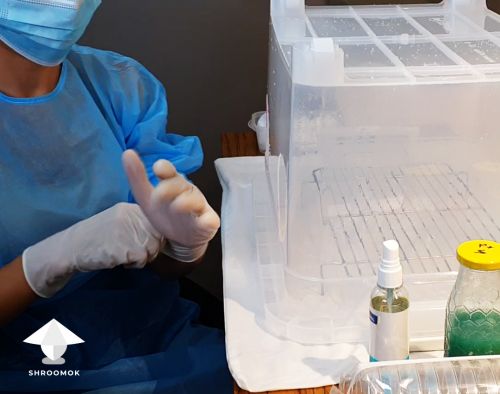
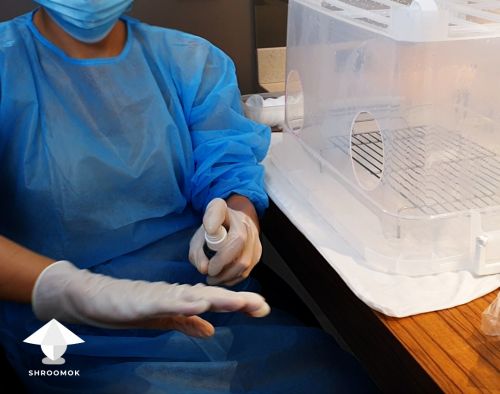
5. Use a raised wire rack to elevate the working surface inside the SAB. Contaminants tend to fall from the air and accumulate mostly at the bottom, so raising the working surface helps reduce contamination risks.
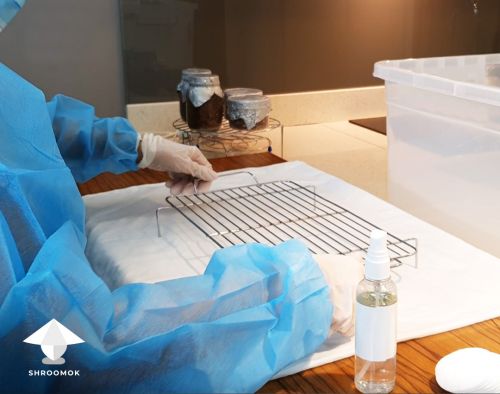
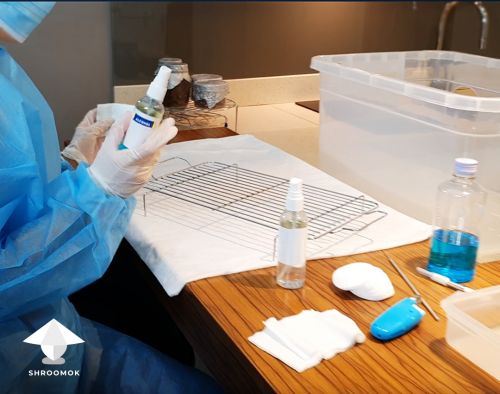
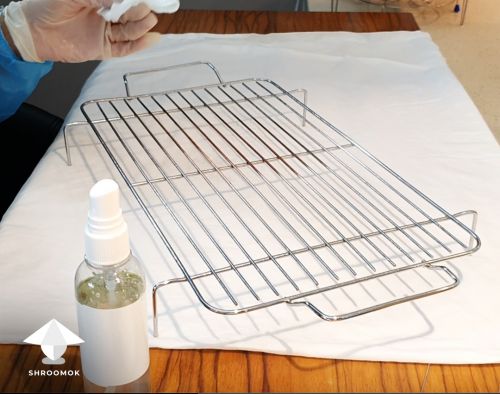
6. Spray or wipe the inside of the SAB with ethyl/iso alcohol (70%).
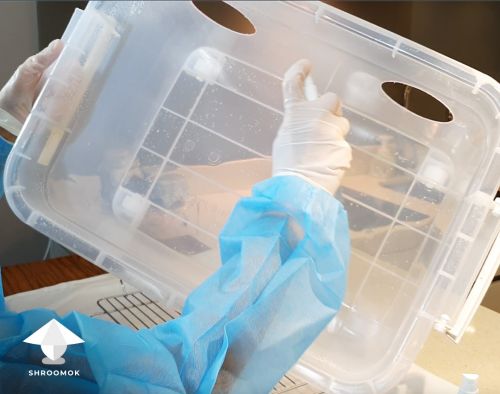
💡 Tip: You can use soap solution instead of alcohol (a few cc/ml per cup of water). Spray the walls of the box (except the front wall) and towel on the bottom to help airborne contaminants stick to the soap film.
7. Before and after any item enters the still air box, wipe it with ethyl/isopropyl alcohol 70%.
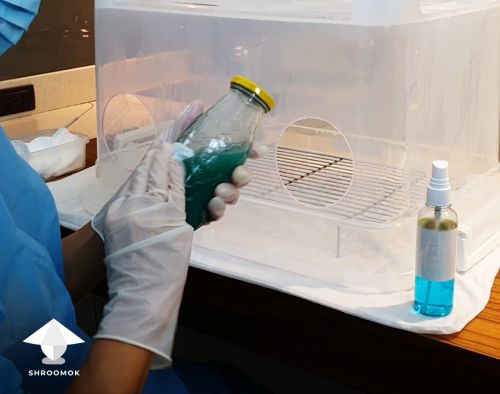
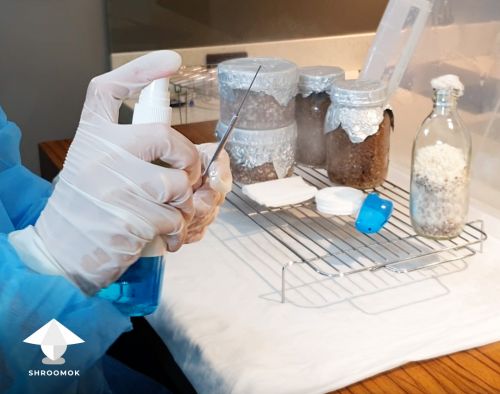
8. Double-check that everything you need for your current project is already inside the SAB.
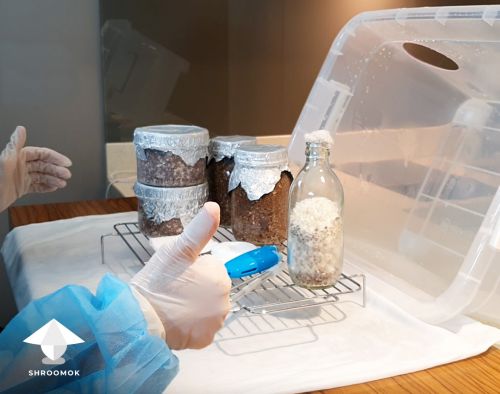
9. Spray the air inside the SAB with 70% isopropyl alcohol and let it sit for a few minutes. This will cause drops to cling to any contamination and pull it down to the bottom.
10. Plan your moves and visualize each step of your work inside the SAB. Once your arms are inside the SAB, avoid taking them out until the job is done. In-and-out movements create additional airflows and increase the risk of contamination.
11. Wipe your gloves with ethyl or isopropyl alcohol (70%).
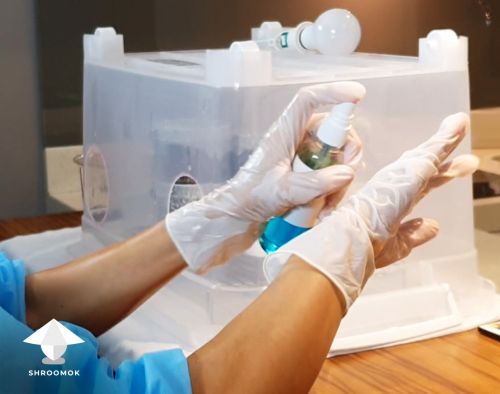
12. Enter the SAB and start your work.
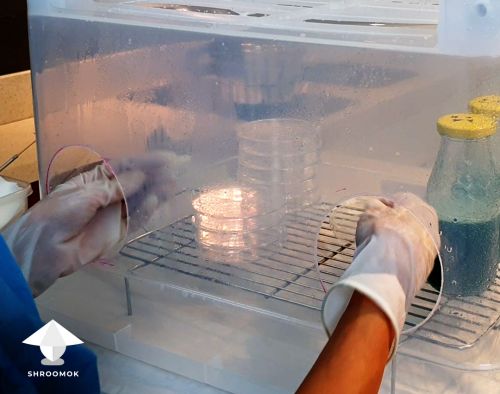
13. Try to work closer to the back wall of the SAB and move smoothly inside. Avoid rushing, but be fast when working with open jars, bags, or agar plates.
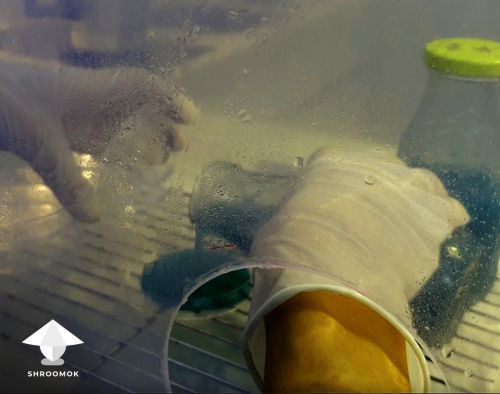
Still Air Box mistakes
Avoid using matted opaque plastic boxes as they make it difficult to see what's happening inside your box. If you have such a box, you can create a 'window' as a workaround. However, working with such a SAB is painful and you can't focus on your moves.
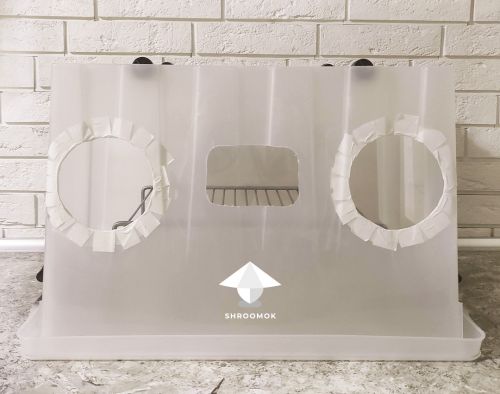
Opt for plastic boxes without stiffeners and with flat, smooth walls. Thick plastic is unnecessary and can make it more challenging to make clean cuts for the armholes.
Still Air Box upgrades
💡 Tip: Consider using an additional light source above the SAB or a Desk Lamp (Amazon). Transparent plastic can slightly distort your vision, so having extra lighting helps. Relying solely on ceiling lights may not provide sufficient illumination while working in the SAB.
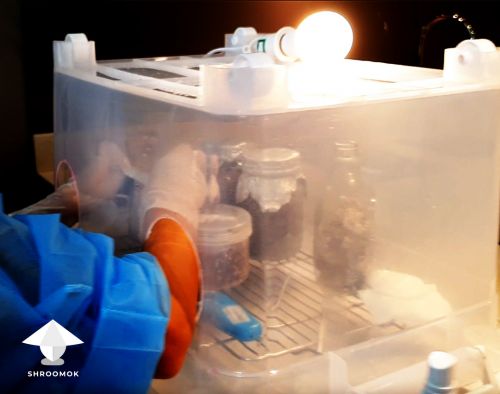
💡 Tip: For additional SAB and tools sterilization you can use UV Sanitizer Lamp (Amazon). UVC light with a wavelength of 200-280 nm wavelength effectively kills contaminants like bacteria, mold fungus, and viruses in the air and on surfaces.
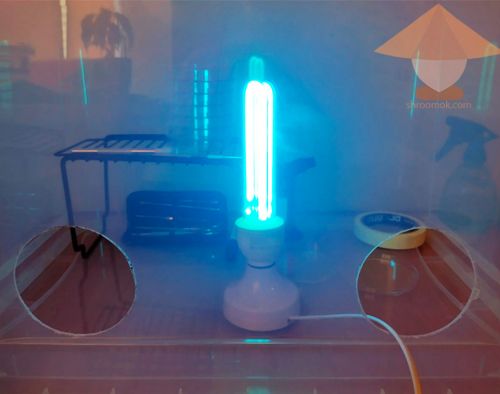
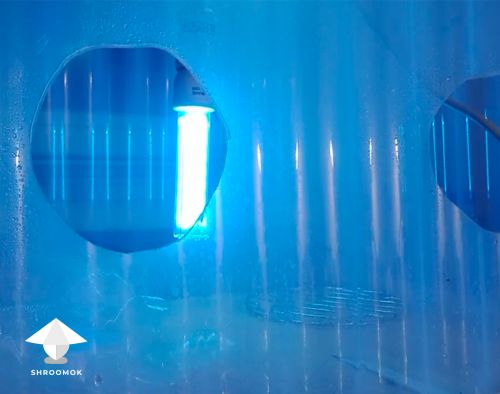
❗️Be careful when using UV light! Never expose your eyes, skin, plants, pets, mushroom spores and mycelium!
You can make as big still air box as you want with using polyethylene and metal/plastic frame. For instance, such SAB setup by Woolf:
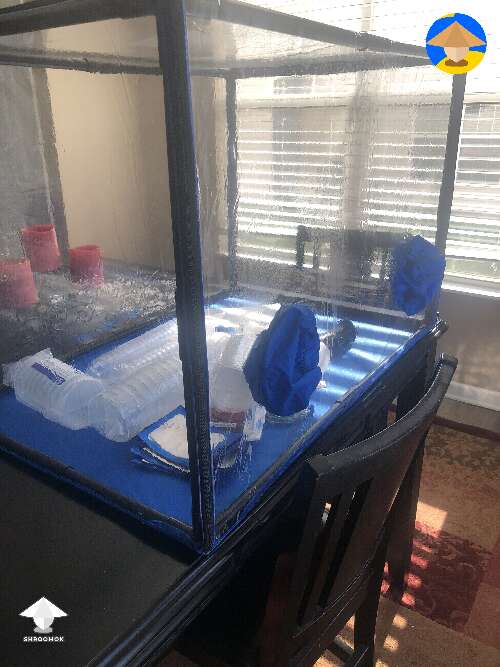
💡 You can find such ready to use Still Air Box on Amazon
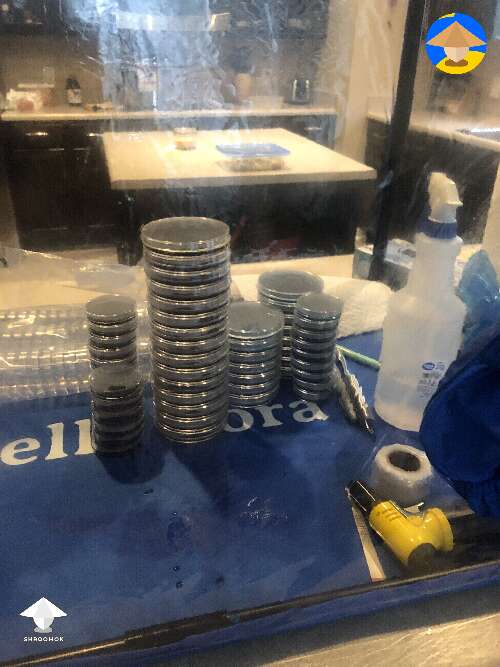
Although it's cost-effective to make it much cheaper by your own.
Can I use flame inside still air box
It is possible to use flame sterilization in a big volume SAB and if you wipe you Still Air Box with soapy water instead of using ethyl/iso alcohol. However, fire creates air currents due to temperature differences inside and outside the SAB, it increases the risk of contamination.
🔥🚫 Don't use flame in the SAB if you use alcohol inside! SAB doesn't have a ventilation; in a small volume alcohol fumes can explode and hurt you. Just wipe your tools with cotton pad soaked in alcohol for sterilization instead of fire.
Can I use SAB as a fruiting chamber
Yes, it is possible to convert the SAB into GrowBox for mushroom fruiting. Simply close the armholes (PE film or plastic circles that were initially cut for making armholes), close the lid on top, and maintain proper fruiting conditions.
Remember to wash and disinfect the box thoroughly if you intend to use it as a Still Air Box again.
Afterwords
During your initial attempts, it's normal to experience uncertain movements in the SAB, which may lead to contaminations.
Keep practicing! With each new project, you'll increase your success rate and advance your skills in mycology.
📸 For more SAB examples check out Still Air Box photo gallery
Join Shroomok Discord Community for questions and sharing your experience.
If you find this guide helpful support my work with subscription or one-time donation on buymeacoffee
Have a happy growing!
Peace, Shroomok ❤️


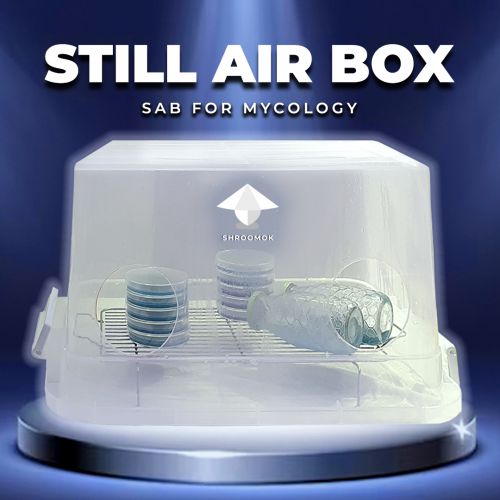
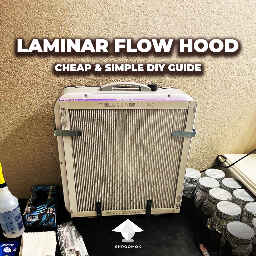

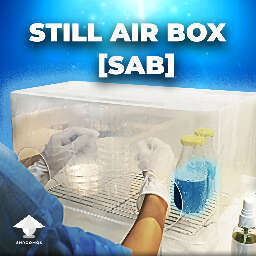


Comments
good, very helpfull
Add comment